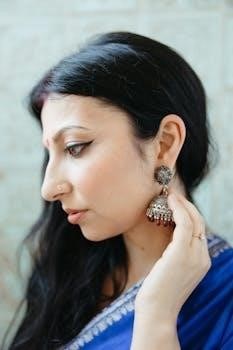nose ring sizing guide

Navigating the world of nose rings involves understanding various measurements. This guide helps you select the perfect fit. Sizing includes gauge (thickness), diameter (for hoops), and length (for studs). Correct sizing ensures comfort and style.
Importance of Correct Sizing
Choosing the right nose ring size is crucial for several reasons. Firstly, an ill-fitting ring can cause discomfort, irritation, and even infection. If a ring is too tight, it can put pressure on the piercing, leading to swelling and pain. Conversely, a ring that is too loose may move around excessively, causing friction and slowing down the healing process; Furthermore, incorrect sizing can affect the overall look of your piercing. A ring that is too small might appear sunken and disappear into the nostril. A ring that is too large could droop or look disproportionate. Proper sizing enhances aesthetics and ensures the jewelry sits correctly, complementing your features. Additionally, the correct gauge (thickness) is necessary to prevent migration or rejection of the piercing. Selecting the appropriate size is essential for comfort, healing, and appearance, guaranteeing your nose ring looks great and feels comfortable.

Understanding Nose Ring Gauge
Gauge refers to the thickness of the nose ring’s post. A lower gauge number means a thicker post. Standard gauges range from 20G to 14G. Gauge impacts comfort and healing.
Gauge Measurement Explained
Understanding gauge is crucial when selecting nose rings. The gauge refers to the thickness of the metal that passes through your piercing. It’s important to note that the gauge system is counterintuitive⁚ the smaller the number, the thicker the jewelry. For instance, an 18 gauge (18G) nose ring is thicker than a 20 gauge (20G) nose ring. This measurement is typically indicated in the packaging or on a sizing chart provided by the jewelry vendor. Knowing your gauge size is the first step to ensuring a comfortable fit. Using the correct gauge helps prevent irritation, rejection, and other issues associated with improperly sized jewelry. If you’re unsure of your current gauge, you can either check an existing piece of jewelry, visit a professional piercer, or use a caliper to measure the thickness of the post. It is a good practice to consult a gauge size chart.
Common Gauge Sizes for Nose Rings (20G, 18G, 16G)
Nose rings come in various gauge sizes, with 20G, 18G, and 16G being the most prevalent. The 20 gauge (20G), which is approximately 0.8mm thick, is considered the standard for many initial nose piercings. It is a thinner option that provides a delicate look and is widely available. Next up is the 18 gauge (18G), which measures around 1.0mm in thickness; this is slightly thicker than 20G and is also a common choice for nostril piercings as it provides a bit more durability. Finally, the 16 gauge (16G) is about 1.2mm thick and is a thicker option often preferred by people who desire a more substantial look or who may have stretched their piercing. It is generally advisable to start with a 20G or 18G gauge, as these are most suitable for initial piercings.

Measuring Your Nose Ring Size
Accurately measuring your nose ring size is crucial for comfort and fit. This involves knowing how to measure the diameter for hoops and the length for studs or barbells.
How to Measure Diameter for Hoops
Measuring the diameter of a nose hoop is essential to ensure a comfortable and aesthetically pleasing fit. The diameter refers to the distance across the inside of the hoop, not the outer edge. To accurately measure, you can use a metric ruler or a caliper, placing it across the inner width of an existing hoop that fits well; If you don’t have a well-fitting hoop, stand in front of a mirror and place the ruler on your nose, aligning it from the piercing hole to the bottom of your nostril. This gives you a rough idea of the diameter you need. Remember, the placement of your piercing on the nostril will influence the ideal diameter. For a more precise measurement, it is best to use a caliper. A comfortable fit ensures that the hoop isn’t too tight or too loose, enhancing both the look and feel of your nose ring.
Measuring Length for Studs and Barbells
When measuring for studs and barbells, the focus shifts from diameter to length. The length refers to the wearable part of the jewelry, which is the straight bar that goes through the piercing. For studs, measure from the base of the decorative end to the start of the backing. For barbells, measure the straight distance between the two balls or decorative ends. It is crucial to measure the wearable length to ensure the jewelry sits comfortably against your skin. Too short and the jewelry can feel tight, causing irritation or discomfort. Too long, and the jewelry will protrude, which can be both annoying and potentially catch on things. It’s best to use a metric ruler or caliper to get an accurate length measurement. Remember to account for the thickness of your nostril when selecting the appropriate length.

Nose Ring Size Chart
A nose ring size chart is essential for accurate sizing. These charts provide conversions between gauge sizes and their corresponding measurements in millimeters, aiding in selecting the right fit.
Gauge to Millimeter Conversion
Understanding the conversion between gauge and millimeters is crucial when selecting nose rings. The gauge refers to the thickness of the jewelry, with smaller numbers indicating a thicker piece. For instance, an 18G nose ring is thicker than a 20G one. To accurately determine the physical size, you need to convert these gauges into millimeters; A 20G nose ring is approximately 0.8mm, while an 18G is around 1.0mm. Using a gauge to millimeter conversion chart, you can easily find the correct millimeter measurement for your desired gauge, ensuring a comfortable and proper fit for your piercing. This conversion helps in selecting the right nose ring when you are buying online or if the nose ring size is not clearly marked. Always refer to a reliable chart to avoid any errors.

Factors Affecting Nose Ring Size
Several factors influence the ideal nose ring size. These include the piercing location, personal comfort, and individual preference. Understanding these aspects is key to a perfect fit.
Piercing Location and Placement
The specific location of your nose piercing significantly impacts the required jewelry size. A nostril piercing, for example, typically uses different dimensions than a septum piercing. The height of the piercing on your nostril determines the necessary diameter for hoops, while the placement affects the length needed for studs or barbells. Piercings closer to the edge of the nostril may require a smaller diameter. The angle of the piercing can also play a role in how the jewelry sits and fits. It is crucial to consider the unique characteristics of your individual piercing to ensure that the chosen jewelry is both comfortable and visually appealing. The location dictates whether you need a hoop, stud, or other type of jewelry, and each will have specific size requirements. Therefore, carefully examine your piercing before selecting any jewelry.
Personal Comfort and Preference
Beyond standard sizing, personal comfort and aesthetic preference play crucial roles in choosing the right nose ring. What feels comfortable for one person might not for another. Some individuals prefer a snug fit, while others prefer a looser one. The choice of gauge, for instance, can come down to personal tolerance; some might prefer the subtle look of a thinner gauge, while others might opt for a thicker one for a bolder statement. The material also affects comfort; some people are sensitive to certain metals. The style of jewelry, such as hoops versus studs, is a matter of personal taste. Ultimately, the perfect nose ring is one that fits comfortably, reflects your style, and makes you feel confident. Don’t be afraid to try different sizes and styles to discover what works best for you. Prioritizing your own comfort and preference is key to enjoying your piercing.